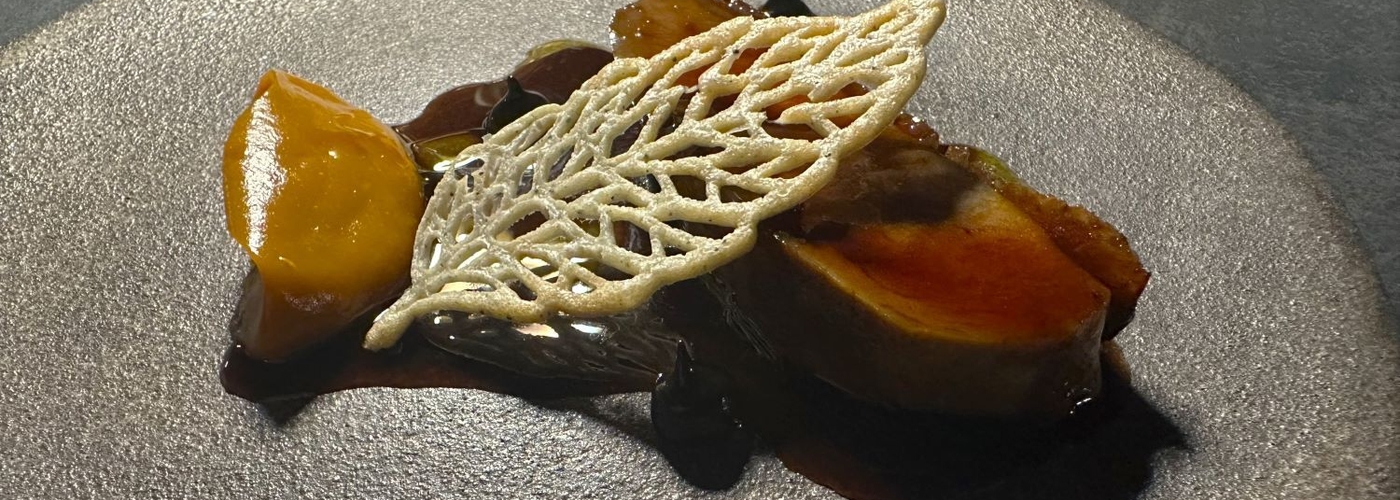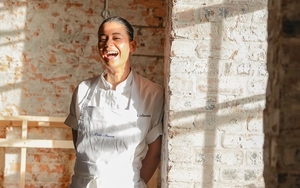Olivia Potts starts worried and finishes entranced in an important new restaurant for the NW
As I do my research before I visit Restaurant 8, I begin to worry that it’s sort of my nightmare restaurant. On its website,it describes itself as ‘immersive and exciting’ and ‘one of the most progressive dining experiences.’ I’m not sure I want to be ‘immersed’; I’m looking for a nice meal, not an escape room.
There’s a very clear chef’s table concept, that serves one tasting menu (priced at £110 per person) over one sitting; all guests are seated at communal tables, and the chef serves as well as prepares dishes in front of them. No thank you.
As I descend the dark, moody staircase into the darker, moodier bar area, I am sure that I don’t want to learn about the creative development of a dish, I just want to enjoy it, and if I’m dining with a friend, I want to be able to speak to them. And I definitely don’t want the chef watching me while I eat (and review) their food. Well, I was wrong.
Our chef manages to be charming, informative, and unassuming. There's no moment when I feel interrupted or awkward
The menu begins in the bar with chef’s snacks: first, a dashi and ponzu meringue topped with cured hamachi (a fatty, white fish), kimchi and sesame. It is sweet and sticky, rich and clean simultaneously, a perfect first bite. It is followed by a mushroom tartlet where even the pastry shell itself is made from cep mushrooms, and a mushroom broth which has hints of those mushroom cappuccinos that plagued fine dining restaurants of the 90s – except this one is delicious. It leaves you wanting more, which is exactly what these little pre-meal bits and pieces should do. Now I’m excited for what’s to come.
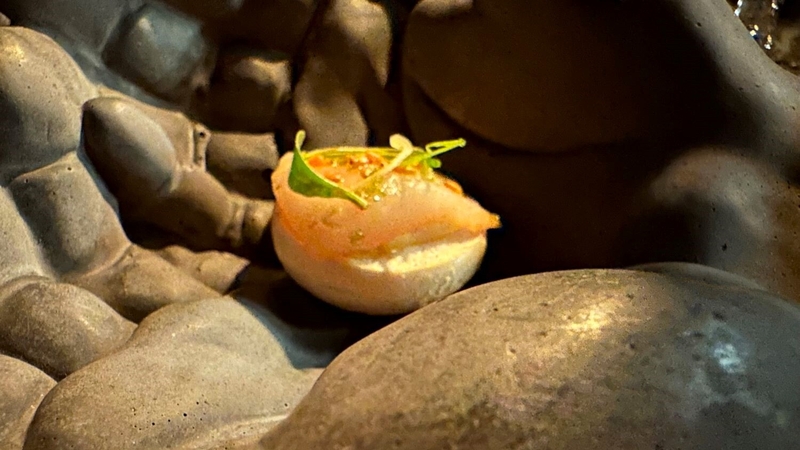
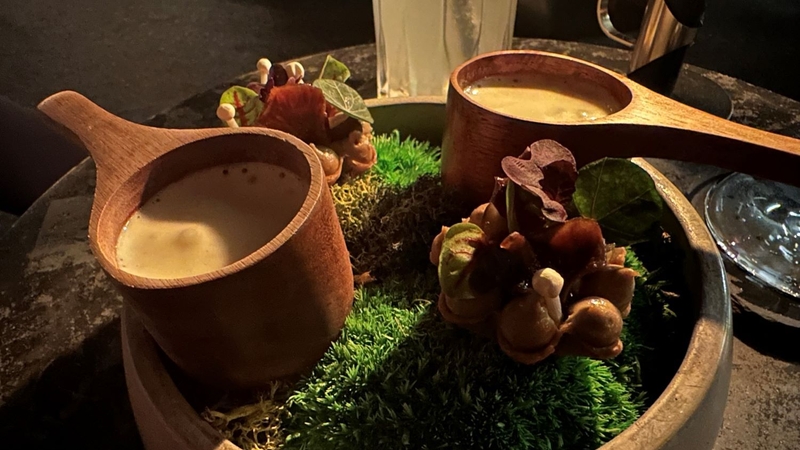
We troop down to the dining room and take our places at the two tables. Our chef passes each of us a little ceviché stone bass tart made with a nori tart shell and cured with nam jim arrives ‘to ease us in.’ With not only this proximity, but the chef acting as service as well as cook, this kind of dining experience lives and dies by the ability of the chef to command the situation: thank God that the chefs are actual angels sent from heaven. Despite not only standing directly in front of me, but cooking a multi-course dinner with countless elements, our chef manages to be charming, informative, and unassuming. There isn’t a moment when I feel interrupted, awkward, or bored by the set-up; it’s less of the performance that I feared and more a genuinely relaxed conversation.
As he talks us through the components, the whole thing feels surprisingly natural. Appropriately eased in, we enter a rhythm of dishes. First chawanmushi, a Japanese, lightly steamed egg custard, seasoned with dashi, and served with pork broth, chive oil and N25 caviar, follows, and is incredibly light and silky, and absurdly comforting. Orkney scallops follow, pan-fried on one side, then basted with smoked butter, a hollandaise that has been seasoned with dehydrated scallop roe and furikake, blow-torched until it begins to bubble and blister, and finally topped with truffle. It’s a lovely dish but more forgettable than the slightly more interesting plates.
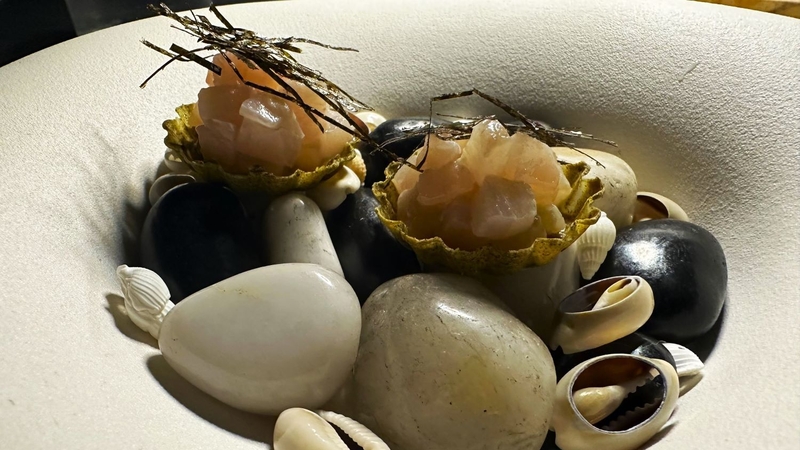
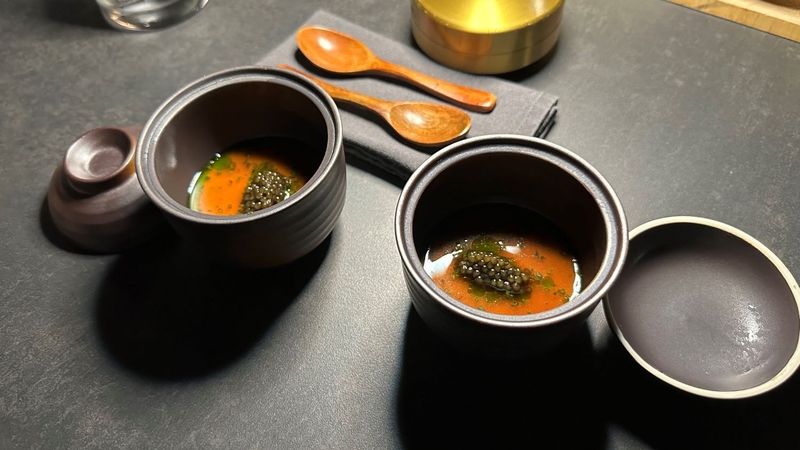

A pan-fried duck breast, brushed with a Douglas fir glaze, is wonderful. Far from tasting like a rear mirror air freshener, the pine is bright and light, appley, like the best extra virgin olive oil you’ve had. The carrot and miso purée which accompanies it is so vibrant, it almost glows in the low light.
Atlantic cod, lightly cured, and crisped on one side comes next. There is caramelised artichoke purée, a mussel sauce made with Nyetimber, and a lobster-head tuile, which, incredibly, does actually taste of lobster. A single dill-pickled mussel sits alongside: my dining companion finds it astringent, a bit of a bully, but for me it is bold and spikey and a canny addition to an otherwise mellow dish.
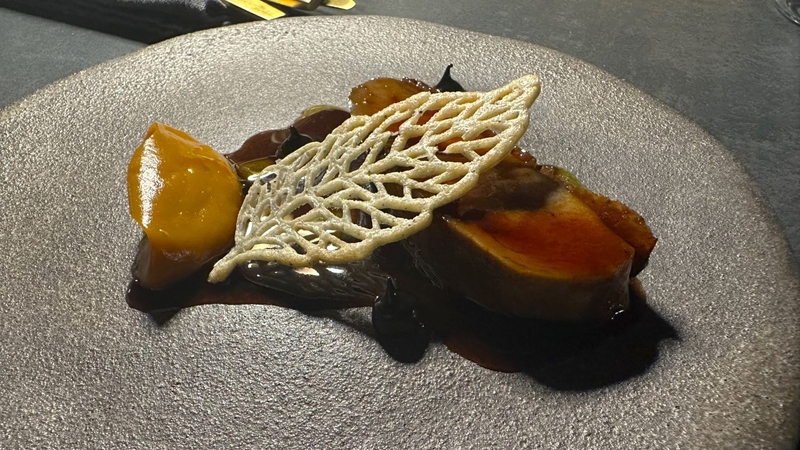

Balmoral venison (gamier, we are told, than less royal varieties) is the final savoury dish, and it’s a show-stopper. It is served with one, plump butter-fried hen of the woods, beetroot ketchup and a damson and juniper sauce. It is pitch perfect: the venison is cooked flawlessly, and the sauce – in fact, all of the saucing across the whole menu – is excellent, glossy and rich and perfectly judged.
Many of the dishes so far have been beautiful, and technically excellent, but they’ve employed classic combinations – fish with dill, venison with juniper – they are considered, but they’re not unusual. In many ways, they’re crowd pleasers.
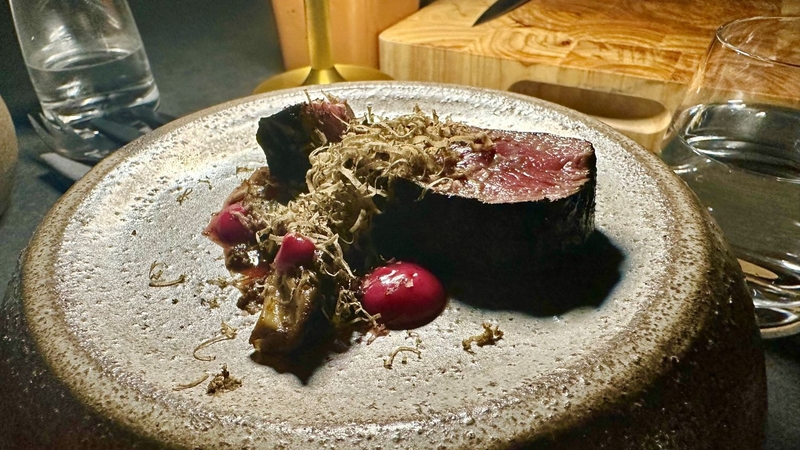
The puddings are more unusual. First is a passionfruit and banana sorbet, with a coconut and malibu foam. It is covered with an exquisite flower made from white chocolate and a yuzu and passionfruit pate de fruit. There’s lime caramel and roasted peanuts which bring welcome depth and complexity.
A rich counterpoint to the tropical lightness of the first pudding is ‘a warm chocolate mousse’. It is served on top of an olive oil cake, a goat’s cheese mousse, a nutty tuile, and cajeta, a goat’s milk caramel. But it’s the goat’s cheese mousse that divides. Sitting just below the dark chocolate, it’s a surprise, a shock, even when you’ve been told it’s coming.
The nubbly tuille made with hazelnuts and kalamata black olives shouldn’t really work, but is so good and compulsive that they should sell them in packs of six, and call them florentines. I love the whole thing. It is bitter and sour and rich and I would never, ever have ordered it – but it’s precisely the right dish at this late point in the meal.
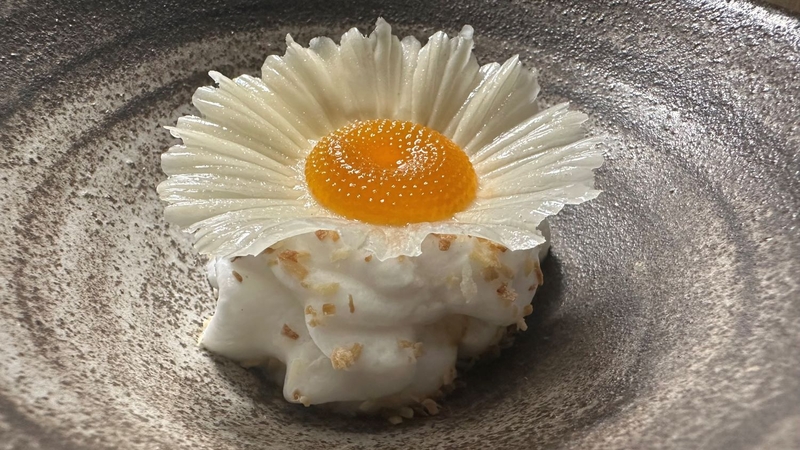
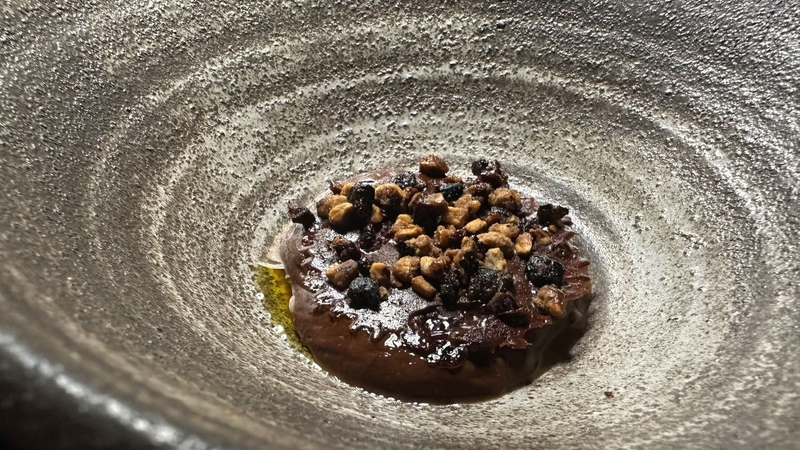
The cheese course makes me laugh: a set cheese custard made from Grana Padano and Lancashire Black Bomb, topped with pineapple caramel and smoked roe is an acquired taste. It’s soft and smokey and deeply, existentially cheesy. I’m a fan, but despite its outward elegance and complexity, it reminds me in both flavour and texture of Dairylea. I manage to ruin the dish for my dining companion by articulating this profound and incisive comparison. But it’s definitely interesting, it’s clever flavour-pairing, it’s cheese-and-pineapple without feeling gimmicky.

The cooking at Restaurant 8 is exemplary, but the experience itself is more than the food on the plate. Still, if this were an escape room, I’m happy to be trapped. It speaks volumes that our neighbouring diners are back here for the second time after their first visit in the Summer; I’d bet that they’ll be back again (and so will I).
Price: £110 set menu per person
Restaurant 8 by Andrew Sheridan, 16 Cook St, Liverpool L2 9RF
The restaurant occupies a very special building by Peter Ellis. Here's what we say about it.
About the writer
Olivia won the Fortnum and Mason Debut Food Book of the Year in 2020, as well as Guild of Food Writers Food Writer of the year. She also writes Spectator Life's Vintage Chef column for The Spectator magazine. She has two books in print, A Half Baked Idea and Butter: A Celebration.
Follow Olivia on Twitter @OliviaFPotts or on Instagram @ahalfbakedidea
The scores
All scored reviews are unannounced, impartial, and ALWAYS paid for by Confidentials.com and completely independent of any commercial relationship. They are a first-person account of one visit by one, knowledgeable restaurant reviewer and don't represent the company as a whole.
If you want to see the receipt as proof this magazine paid for the meal then a copy will be available upon request.
Venues are rated against the best examples of their type. What we mean by this is a restaurant which aspires to be fine dining is measured against other fine dining restaurants, a mid-range restaurant against other mid-range restaurants, a pizzeria against other pizzerias, a teashop against another teashops, a KFC against the contents of your bin. You get the message.
Given the above, this is how we score: 1-5: saw your leg off and eat it, 6-9: sigh and shake your head, 10-11: if you’re passing, 12-13: good, 14-15: very good, 16-17: excellent, 18-19: pure class, 20: nothing's that good is it?
-
Food
Chef’s snacks 8 Cured stone bass 8 Chawanmushi 9 Scallops 8 Duck breast 9 Cod 9 Venison 9 Passionfruit and banana 10 Warm chocolate mousse 9 Cheese custard 8
-
Service
It defies the rules of hospitality that sitting within half a foot of the chef should feel easy and enjoyable, especially when they are also effectively service staff, but somehow, it works.
-
Ambience
The lighting is a bit too moody and the music a bit too insistent


